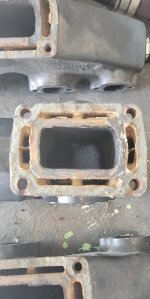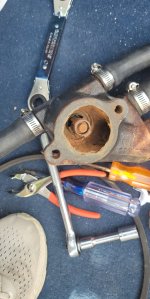Jason Boatman
Cadet
- Joined
- Jun 27, 2022
- Messages
- 6
I have a 94 Genesis, Volvo Penta 4.3. I bought on consignment two years ago from a boat shop. Who, according to them had went through the boat and maintained regular maintenance. After going through this boat myself now, I can tell that was a lie, and needless to say the boat shop is now closed (and there's only one other shop open where I live) I may have not winterized it properly this last year, my first time working on them. When I pulled the plugs at the end of the year, no water came out, but it had sat for most of the season. I managed to get all the water out of the cooling system and filled it up with some of that boat antifreeze.
Took her out twice this year and she ran great, all day long, no issues. Then took her out this last weekend, and almost immediately ran into problems. Engine overheated and became hydro locked. I checked the oil right then and there and level was good.
Took her out of the water, and got the engine free, but wouldn't start. Checked the oil and it was quart over. Pulled the plugs and they were foul, and there was water in the cylinders, but not a ton (like I've seen in videos). Checked the oil and it was grey and smelled like gas (explains why we were over). There also may have been water in it, but it was hard to tell.
Changed the oil, running a quart or two through it to get the grey out, and changed the plugs. At the same time did compression test and was over 135 -150 on all cylinders. Engine fired right up, and ran great like always until we cut it off.
Pulled the water pump and the impeller was toast, but still intact for the most part, not a lot of rubber lost in the system (but still some, just at least not the whole impeller). Looks like we sucked up quite a bit of sand, as there was some sand stuck in the impeller and throughout the system. Pulled thermostat and it's badly corroded, not sure how it even worked prior. Pulled exhaust manifold and risers, also badly corroded. Pulled the intake manifold and found a little bit of rubber from the impeller sitting right inside the top of the engine. Which, I don't think that could have got through a crack.
I would like to go head and replace the pump, thermostat & housing, exhaust manifold & risers, but I'm hesitant to do that as I am worried that would be futile if we have a crack in the engine.
What is everyone's thoughts on this?
Tia
Took her out twice this year and she ran great, all day long, no issues. Then took her out this last weekend, and almost immediately ran into problems. Engine overheated and became hydro locked. I checked the oil right then and there and level was good.
Took her out of the water, and got the engine free, but wouldn't start. Checked the oil and it was quart over. Pulled the plugs and they were foul, and there was water in the cylinders, but not a ton (like I've seen in videos). Checked the oil and it was grey and smelled like gas (explains why we were over). There also may have been water in it, but it was hard to tell.
Changed the oil, running a quart or two through it to get the grey out, and changed the plugs. At the same time did compression test and was over 135 -150 on all cylinders. Engine fired right up, and ran great like always until we cut it off.
Pulled the water pump and the impeller was toast, but still intact for the most part, not a lot of rubber lost in the system (but still some, just at least not the whole impeller). Looks like we sucked up quite a bit of sand, as there was some sand stuck in the impeller and throughout the system. Pulled thermostat and it's badly corroded, not sure how it even worked prior. Pulled exhaust manifold and risers, also badly corroded. Pulled the intake manifold and found a little bit of rubber from the impeller sitting right inside the top of the engine. Which, I don't think that could have got through a crack.
I would like to go head and replace the pump, thermostat & housing, exhaust manifold & risers, but I'm hesitant to do that as I am worried that would be futile if we have a crack in the engine.
What is everyone's thoughts on this?
Tia
























